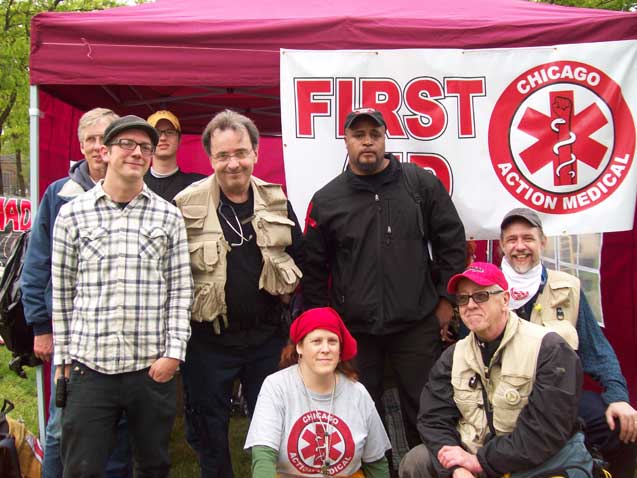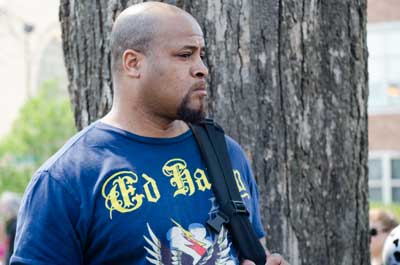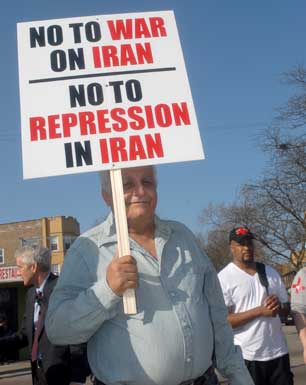On March 27, Chicago teachers and their supporters – including parents, students and community residents – rallied against the largest mass public school closure in US history. News of the mobilization sparked huge public interest before the demonstration – including from an undercover police officer calling himself “Danny Edwards.”
The day before the big rally, “Danny” reached out in individual emails to fellow volunteer street medics he had met a year earlier after he took a 20-hour training with Chicago’s local street medic collective, Chicago Action Medical (CAM). CAM’s volunteer emergency medical technicians (EMTs), nurses, doctors and trained street medics provide emergency medical treatment at local protests.
His aim in reaching out: to learn more about the next day’s plans.
“Danny” – who admitted to us on May 6 that he is, in fact, a Chicago police officer – could have saved himself the trouble and his department the expense. After all, organizers had already coordinated directly with top CPD brass about their plans for the next day and widely promoted their intent to stage nonviolent civil disobedience.
After the CTU rally, “Danny” also tried to recruit at least one CAM volunteer street medic via email on April 30, the day before a May 1, 2013, immigrants’ rights march, to pair up with him as a partner. There were no takers, so he showed up alone at the rally sporting marked medic regalia.
His latest undercover sortie as a fake volunteer street medic bookends a hectic year for him.
The Paper Trail
“Danny” was a fixture at CAM events beginning in early March 2012, when he participated in a 20-hour introductory training for new street medics – a training he described in an email to CAM volunteer street medic Scott Mechanic as “great.”
 May 1, 2012: “Danny Edwards” – posing with fellow Chicago Action Medical volunteers at their health care booth in Union Park, where street medics were volunteering to provide first aid and emergency health care for participants at the annual May Day rally and march. “Danny” – the only medic not smiling – is standing in front of the CAM banner.
May 1, 2012: “Danny Edwards” – posing with fellow Chicago Action Medical volunteers at their health care booth in Union Park, where street medics were volunteering to provide first aid and emergency health care for participants at the annual May Day rally and march. “Danny” – the only medic not smiling – is standing in front of the CAM banner.
The email address “Danny” used in that correspondence, which he did not sign by name, was pegged to the name of a Chicago police officer cited months later in court documents involved in undercover work around the NATO protests.
Less than half an hour after sending that initial email, “Danny” sent the first in a flurry of emails to Mechanic from a different email address, writing “let me know what going on so i can get involved (sic).”
“Danny’s” March 2012 foray into spying on CAM aligns with the date prosecutors say the Chicago Police Department (CPD) posted two other undercover agents who went by the street names “Mo” and “Nadia” on a 90-day temporary duty undercover assignment to Field Intelligence Team 7150. That team was tasked with infiltrating Occupy and anarchist groups in the run-up to the NATO Summit, according to court documents filed by Cook County State’s Attorney Anita Alvarez in April 2013.
Those two officers, “Mo” and “Nadia,” are also purported linchpins in the criminal cases against five activists known as the “NATO 5,” three of whom are scheduled to go to trial on NATO-related domestic terrorism charges this September.
The NATO prosecutors’ October 2012 Answer to Discovery lists this same police officer among the CPD officers, detectives and other police officials who may be called to testify in this fall’s upcoming trial. He is also mentioned in the NATO defendants’ February 25, 2013, Motion to Compel Discovery as “a CPD undercover officer related to this investigation.”
Busy Year for “Danny” – and Early Red Flags
Five days after he inadvertently emailed Scott Mechanic under his given name and scrambled to cover his tracks, “Danny” acted for the first time as a CAM street medic at a small permitted peace march on Chicago’s north side. The March 18, 2012 event was organized to mark the anniversary of the launch of the Iraq War in March 2003.
 May 1, 2013: “Danny Edwards,” undercover Chicago police officer, at a May Day rally for immigrant rights in Chicago’s Union Park.“Danny” ran again as a marked CAM street medic on April 7, 2012 at Occupy Chicago’s “Occupy Spring” event, also emailing Mechanic on April 26, 2012 about bringing a “friend” to an upcoming health workshop. On May 1, 2012, he volunteered as a marked CAM street medic at a May Day rally and march, where his refusal to follow CAM operational guidelines – reportedly abandoning his street medic partner to make a b-line for a group of young protesters wearing black clothes – began to raise real alarms with fellow street medics.
May 1, 2013: “Danny Edwards,” undercover Chicago police officer, at a May Day rally for immigrant rights in Chicago’s Union Park.“Danny” ran again as a marked CAM street medic on April 7, 2012 at Occupy Chicago’s “Occupy Spring” event, also emailing Mechanic on April 26, 2012 about bringing a “friend” to an upcoming health workshop. On May 1, 2012, he volunteered as a marked CAM street medic at a May Day rally and march, where his refusal to follow CAM operational guidelines – reportedly abandoning his street medic partner to make a b-line for a group of young protesters wearing black clothes – began to raise real alarms with fellow street medics.
After “Danny’s” behavior on May Day, a number of veteran CAM volunteers – including Mechanic – moved immediately to isolate him from new and less experienced street medics, to monitor his behavior closely and to broadly urge the practice of good security culture.
But without a smoking gun, they were unwilling to expose him publicly. The chill from veteran street medics didn’t discourage “Danny” from continuing to reach out and show up to actions.
On May 11, a week and a half later and as local organizers were scrambling to find housing for out-of-town protesters traveling in for the demonstrations, he emailed Mechanic directly for information about housing that other groups or collectives might be offering. “I have a group of friends in need and I wanted some direction,” he wrote.
On May 20, 2012, at a large protest against the NATO Summit, CAM street medics demanded that he remove his medic markings after he again ignored CAM street operations protocols by deserting his partner to sprint after a group of protesters clad in black clothes.
“Danny” sent emails to individual members of CAM’s listserv – but almost never to the larger listserv – strategically for the next year, seeking information about upcoming demonstrations and meetings. The off-list queries continued to raise red flags with CAM members he contacted, some of whom had never met him and did not know who he was.
When we asked “Danny” at the 2013 May Day rally to confirm his name and identity as a CPD officer, he insisted he was “Danny Edwards” and claimed to be a friend of a local activist.
That’s not how the activist described “Danny” to CAM volunteers at a street medic training before the NATO protests last spring. At that training, he told CAM members that “Danny” had recently befriended him, and he raised concerns there about “Danny’s” interest in topics ranging from Molotov cocktails to property damage.
“NATO 5” Connection
According to court documents released in the months after the NATO Summit protests, “Danny”is one of the undercover officers at the heart of the “NATO 5” criminal cases. He’s mentioned in the pre-NATO Summit pre-emptive raid search warrant documents as “Undercover Officer C,” and is also cited by his given name in court documents for one of the NATO defendants, Sebastian “Sabi” Senakiewicz, as a potential trial witness.
We tried to question “Danny” about his undercover activities on May 6 at a house that had a sheet of paper with his given name and phone number taped to the front door. While he admitted he was, in fact, the named police officer he’d denied being just five days earlier, he declined to answer our questions.
“Danny’s” post-NATO activities raise a key question: Why keep an undercover officer in play as a volunteer street medic in a nonviolent health-care project almost a year after the NATO protests that ostensibly put him into motion as a police spy in the first place?
It’s virtually impossible to say from the official record. That’s because the CPD and Cook County State’s Attorney Anita Alvarez have fought tooth and nail in court for almost a year to prevent defense attorneys in the remaining NATO cases from learning more about the scope and character of police spying on political activity leading up to last year’s NATO Summit.
At a “NATO 3” status hearing on May 14, 2013, prosecutors again opposed disclosing information about the wider scope of police spying on Chicago’s activist groups (as they have before in official court filings) in the months leading up to the NATO Summit. Defense attorneys rebutted in open court – as they did in writing earlier in their April 30, 2013, “Reply to the State’s Response to Defendants’ Motion to Compel” – that this information remains directly relevant to the NATO cases because it would broaden the context of the arrests of the NATO 3 and the CPD’s pre-NATO spying efforts targeting the activist community.
Broader Context
Police spying in recent years has targeted peace groups, environmentalists and the Occupy movement, a focus on protest as a potential flashpoint of “terrorism” that sometimes has disastrous consequences. By way of example, in Boston, local police focused their attention on the political activism of local residents at the same time they missed the threat posed by the Boston Marathon bombers.
And law enforcement has also demonstrated a disturbing pattern of working undercover to create crime to prosecute crime. Notable cases like the “Cleveland 4” fit into a pattern that journalist Arun Gupta has described as law enforcement’s “war of entrapment against the Occupy movement.”
Law enforcement infiltration in Chicago in the run-up to the 2012 NATO Summit unfolded most publicly with the use of at least two undercover cops who went by the names “Mo” and “Nadia.”
Both were regular fixtures at a spring 2012 encampment to try to prevent the closure of the Woodlawn Mental Health Clinic on Chicago’s south side, one of six public mental health clinics slated for closure by city officials and hardly a flashpoint of “potential terrorist activity.” They also showed up at one point at an independent media center organized to cover the NATO protests and at numerous other documented locales in the two and a half months before the NATO Summit.
“Red Squad” 2.0 Rolling Back into Town?
Ongoing police spying a year after the NATO meeting by “Danny” – and potentially others – raises a real alarm among activists, including CAM street medics, whose national community traces its origins to the Medical Presence Project of the Medical Committee for Human Rights (MCHR).
MCHR was first formed in 1964 to provide medical assistance to the civil rights movement. Its Chicago-based volunteers, who also provided medical aid at protests organized by peace projects and student groups opposed to the Vietnam War, were among thousands of civilians spied on by the CPD’s notorious Red Squad.
“The CPD’s decision to plant an undercover police spy in Chicago Action Medical is outrageous, but sadly, comes as no surprise,” said CAM street medic Dick Reilly in an interview. “The CPD has a long and sordid history of surveillance and infiltration of labor, peace and social justice groups dating back to the 1886 railroading of the Haymarket defendants – efforts that led to the creation of Chicago’s infamous Red Squad. Over a hundred years later, the cops are clearly still at it.”
For Reilly, CAM’s ongoing infiltration threatens core freedoms that range from the privacy rights of the people they treat to police officials’ ongoing assault on dissent in the city.
“When the CPD targets a volunteer medical project like CAM – which seeks to provide basic first aid to people exercising their democratic rights and whose primary principle is to ‘do no harm’ – it underscores the lengths to which they’ll go to criminalize dissent, suppress resistance and pander to the agenda of the political and economic elites they actually serve and protect,” Reilly said.
The Chicago Red Squad’s abuses of basic constitutional rights were so egregious – targets included the Parent-Teachers’ Association and the League of Women Voters – that a federal court slapped the city with a consent decree in 1982 that expressly barred politically motivated police spying unless police could show at least some evidence of criminal intent on the part of the targets of their spying.
The city was finally able to win relief from the consent decree in January 2001, after arguing for years constitutional protections thwarted its ability to investigate gangs and “terrorism.”
The consent decree’s demise hasn’t kept the CPD out of hot water for spying on political projects, either, beginning as early as 2002. Were the old consent decree still in place, CAM members believe “Danny’s” undercover spying on their work over the past year would have been illegal.
McCarthy’s Spy-Ops Background at NYPD, Newark PD
Just before he was sworn in as Chicago’s new mayor in May of 2011, Rahm Emanuel – a former US Congressman and chief of staff for President Obama – announced the appointment of new police superintendent Garry McCarthy. Three months later, McCarthy created an intelligence-gathering unit tasked to perform “counter-terrorism” work in preparation for the May 2012 NATO meetings.
A career New York cop, McCarthy is no stranger to the use of systematic police spying.
The New York Police Department (NYPD) has a contentious track record in this arena, prompting the implementation of New York’s own version of Chicago’s Red Squad consent decree – the Handschu Decree – while McCarthy was climbing up the NYPD’s ranks to a senior command position.
It wasn’t long after he formally assumed the mantle of CPD superintendent in 2011 that McCarthy drew fire for allowing the latest iteration of New York’s police spy ring to operate in Newark, NJ, where he had served as police chief before taking the position as CPD’s top dog.
McCarthy also served as an NYPD commander when the police set up spy rings before the 2004 Republican National Convention in New York City and during “CIA on the Hudson,” the joint NYPD/CIA project that was set up and run by former CIA Deputy Director for Operations David Cohen to “map the human terrain” of New York City’s Islamic community.
Targeting Street Medics
Volunteer street medics have historically been an attractive target for undercovers.
CAM street medic Scott Mechanic met “Anna,” before she was outed as a police infiltrator, an FBI informant who used her position as a street medic to befriend and entrap environmental activists. One of those activists, Eric McDavid, is serving a 20-year sentence in a case built around Anna’s testimony and her reported entrapment activities.
In the wake of Hurricane Katrina, Mechanic was also a street medic volunteer at New Orleans’ Common Ground Collective, where he and dozens of other volunteer health-care providers ran into Brandon Darby, an agent provocateur and FBI informant at the heart of another entrapment case, this one against David McKay and Bradley Crowder.
“These kinds of informants and undercover police represent a real threat to activists, in no small part because they’re committed to manufacturing crime where none exists to terrorize the public and justify their abuses of our right to dissent,” said Mechanic. “This Chicago cop’s infiltration of our group raises real questions about police intrusion into protesters’ medical histories – and it’s a truly despicable example of exploiting people’s caregivers as part of the national campaign to criminalize dissent.”
Convergence of the War on Drugs, War on Terrorism
As a Chicago cop, the CPD officer who infiltrated CAM has worked on narcotics and gang cases, including as an undercover officer.
Given the growing conflation of the “War on Drugs” with the “War on Terrorism,” which is increasingly married to a War on Dissent, it’s not surprising that the Chicago police officer who infiltrated CAM would segue into COINTELPRO-style undercover work. By the 1990’s, the CPD was listing dissidents by alleged political affiliation in their gang database, in tandem with then-Mayor Richard M. Daley’s claim that the Red Squad Consent Decree shackled cops’ ability to investigate both gangs and “terrorism.”
Shahid Buttar, executive director of the Bill of Rights Defense Committee, points to the delayed notice search warrants enabled by Section 213 of the USA PATRIOT Act – presented to the public as a counter-terrorism tool – as a key example of the War on Drugs’ convergence with the War on Terrorism.
“Both the War on Drugs and the War on Terrorism have long represented cash cows for law enforcement and intelligence agencies, from the FBI all the way down to local police departments,” Buttar said in an interview. “Beyond the serial corruption of agencies pimping public fears to inflate their budgets, many particular powers claimed as necessary for one ‘war’ are actually used more in the other.”
The Chicago Police Department did not respond to our phone calls or emails about this story.
